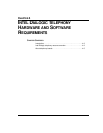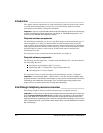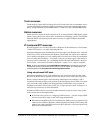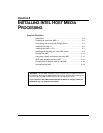
4-4 INSTALLING INTEL TELEPHONY COMPONENTS
Some TeleVantage features such as call recording will require RTP resources even for
SIP-to-SIP calls.
Note:
A host-based VoIP stack is recommended for all new installations. You must use a
host-based stack if any of the following apply to you.
You plan to use the Session Initiation Protocol (SIP) to enable VoIP communications
with SIP phones or softphones, SIP services, SIP carriers, or PSTN gateway devices.
You have a DI0408LSAR2 integrated analog trunk and station board, which requires a
host-based stack.
You want to access the conference resources on IP telephony boards that provide them.
You have multiple Internet telephony boards in your TeleVantage Server, and you want
all incoming VoIP calls at a single IP address.
You want to divide your Internet trunks into multiple spans with different IP addresses,
for example, one inside your firewall and one outside.
Note:
Mixing host-based and embedded based stacks in the same PC is not supported.
Using an embedded H.323 stack
Important: Intel Dialogic SR 5.1.1 SU 107, included with TeleVantage 7.5, does not support
embedded stack. Embedded stack is only supported by Intel Dialogic SR 5.1.1 SU 69, included
with TeleVantage 7.
Some legacy Internet telephony boards can be configured to use an embedded H.323 stack. (See
the Trunk Resources by Board table in Appendix E for boards that you can use with an
embedded stack.)
With an embedded H.323 stack, the H.323 call control and RTP resources run on the board’s
digital signal processor (DSP), off-loading the TeleVantage Server’s CPU.
Voice resources
Voice resources carry out audio-processing tasks such as recording or playing audio, and
detecting touchtone digits. The TeleVantage features intercom, paging, voice-first answering,
system call recording, beep on call recording, forwarding calls to external numbers, and external
station calls also use voice resources (external stations can optionally be configured to not
require voice resources.) Some voice resources may also support fax, FSK, and CSP
capabilities.
For guidelines on determining how many voice resources your system needs, and for
instructions on how to install more voice resources, see Appendix A.


















